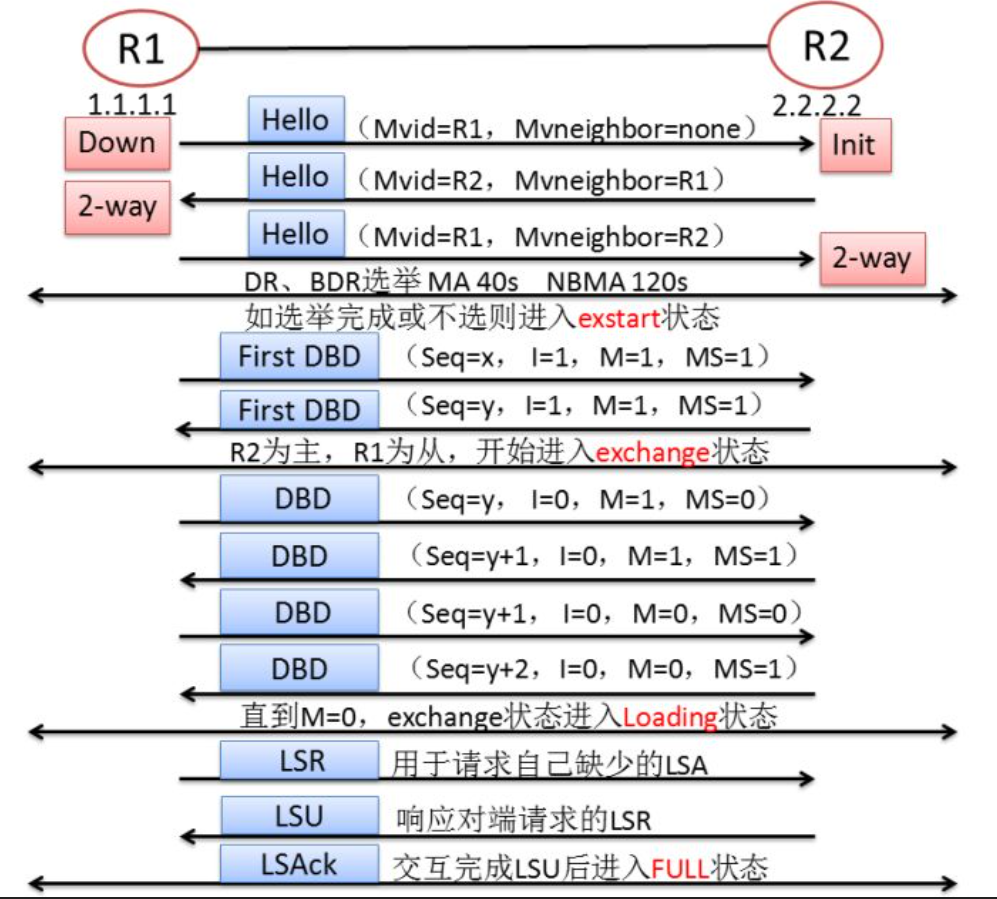动态路由协议知识总结1
动态路由协议知识总结1
动态路由协议:路由器之间用来交换路由信息的规则,根据协议规则,路由器之间能够彼此互相学习路由信息;在网络中传递动态路由协议相关信息,进行协调,时间动态路由的目标,减少人工干预管理,实现工作量的减少。
其中动态路由协议分成两类:内部网关协议(IGP Interior Gateway Protocol)和外部网关协议(EGP Exterior Gateway Protocol)
内部网关协议 IGP (Interior Gateway Protocol):RIP 最多支持15个路由器,16个就出问题、
EIGRP 增强型RIP,最多支持255个,为Cisco独自开发并使用、
ISIS 开放免费协议,支持路由器数量无限制,但是在CLNP(无连接网络协议Connection-Less Network Protocol)基础上开发的,但CLNP不流行,ISIS就挂了。但目前
ISIS以及改进,能支持IP协议,所以又重新流行;一般超大型网络用ISIS,比如运营商就用ISIS
OSPF (Open Shortest Path First)仿照ISIS开发的协议,规模也无限制,并基于IP协议,因IP比较流行,OSPF也因此更流行。但OSPF的扩展性比不上ISIS,所以企业级的网络用OSPF,如城域网等。
OSPF协议的特点:可适应大规模网络、路由变化收敛速度快、构建路径最短的无环的路由网络、支持变长子网掩码VLSM。
OSPF是链路状态路由协议,并且是公有标准协议。
OSPF的工作过程(所有的高级路由协议过程都一样):建立邻接表(路由器彼此学习)、同步数据库(路由器彼此学习)、计算路由表(路由器独自计算)
内部网关协议(IGP)是一种专用于一个自治网络系统(比如:某个当地社区范围内的一个自治网络系统)中网关间交换数据流转通道信息的协议。网络IP协议或者其他的网络协议常常通过这些通道信息来决断怎样传送数据流。目前最常用的内部网关协议分别是:路由信息协议(RIP)和最短路径优先路由协议(OSPF)分级的链接状态路由协议(ISIS)。
IGP协议细分:距离矢量路由协议和链路状态路由协议
距离矢量路由协议:路由器之间传递的是“路由条目”信息,如:RIP和EIGRP;彼此直接提供的是路由条目;也因为给的是路由条目,收到的路由条目的是不能变更的,变了就与原来不同,失去意义了。从原理上就失去的其灵活性。
链路状态路由协议:路由器之间传递的是“链路状态”信息,如:ISIS和OSPF;彼此给的是链路状态,由各路由器自己计算路由;因为给的都是链路状态信息,给了各路由器灵活性,自己计算,按照统一的计算规则进行,就都是沿着相同的路由行进。
外部网关协议 EGP (EGP Exterior Gateway Protocol):BGP在公司间协议,并用的TCP协议,在公司间传递路由非常稳定。
外部网关协议(EGP)是一种在自治系统的相邻两个网关主机间交换路由信息的协议。 EGP 通常用于在因特网主机间交换路由表信息。它是一个轮询协议,利用 Hello 和 I-Heard-You 消息的转换,能让每个网关控制和接收网络可达性信息的速率,允许每个系统控制它自己的开销,同时发出命令请求更新响应。路由表包含一组已知路由器及这些路由器的可达地址以及路径开销,从而可以选择最佳路由。每个路由器每间隔 120 秒或 480 秒会访问其邻居一次,邻居通过发送完整的路由表以示响应,代表协议是边界网关协议(BGP)。
边界网关协议 BGP(Border Gateway Protocol)
边界网关协议(BGP)是一种运行在自制系统间的路由协议,主要作用交换域间路由协议
自治系统 AS(autonomous system)
自治系统(AS)是一组内部管理下的网络,它们之间共享同一个路由选择方法。它由地区再划分并必须由IANA分配一个单独的16位数字。地区通常连接到其他地区,使用路由器创建一个自治系统。作用就是在运行BGP等外部路由协议时用于区分不同自治系统。
IGP与EGP区别,图形标识如下:

第一、OSPF协议介绍
1、OSPF包含在IP数据包中,协议号为89
2、OSPF报文


相关英文解释:
-
- Hello
- Database Description
- Link state request
- Link state update
- Link state Acknowledgment
Let's discuss each packet in detail.
1. Hello packet
The Hello packet is used to create a neighborhood relationship and check the neighbor's reachability. Therefore, the Hello packet is used when the connection between the routers need to be established.
2. Database Description
After establishing a connection, if the neighbor router is communicating with the system first time, it sends the database information about the network topology to the system so that the system can update or modify accordingly.
3. Link state request
The link-state request is sent by the router to obtain the information of a specified route. Suppose there are two routers, i.e., router 1 and router 2, and router 1 wants to know the information about the router 2, so router 1 sends the link state request to the router 2. When router 2 receives the link state request, then it sends the link-state information to router 1.
4. Link state update
The link-state update is used by the router to advertise the state of its links. If any router wants to broadcast the state of its links, it uses the link-state update.
5. Link state acknowledgment
The link-state acknowledgment makes the routing more reliable by forcing each router to send the acknowledgment on each link state update. For example, router A sends the link state update to the router B and router C, then in return, the router B and C sends the link- state acknowledgment to the router A, so that the router A gets to know that both the routers have received the link-state update.





【推荐】国内首个AI IDE,深度理解中文开发场景,立即下载体验Trae
【推荐】编程新体验,更懂你的AI,立即体验豆包MarsCode编程助手
【推荐】抖音旗下AI助手豆包,你的智能百科全书,全免费不限次数
【推荐】轻量又高性能的 SSH 工具 IShell:AI 加持,快人一步
· TypeScript + Deepseek 打造卜卦网站:技术与玄学的结合
· Manus的开源复刻OpenManus初探
· AI 智能体引爆开源社区「GitHub 热点速览」
· 三行代码完成国际化适配,妙~啊~
· .NET Core 中如何实现缓存的预热?